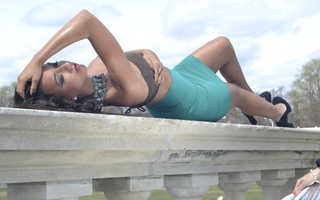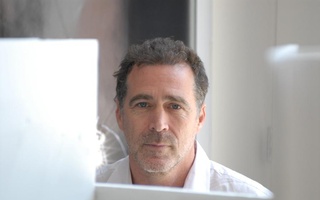Biannually hundreds of industry leaders travel to four cities for a month of back-to-back shows in multiple venues, models are rushed in and out of shows for drastic makeup, hair, and outfit changes, and designers obsess far in advance over music, theme, seating arrangements, and venue for a 20-minute presentation.
You’d think that someone at some point would have consolidated and systematized Fashion Week and fashion shows. Indeed, in recent years, several designers have turned to video as a cheaper and more efficient option. But the fashion show affords designers the chance to overwhelm through spectacle in conjunction with the drama of contingency, which cannot translate to video, and thus preserves the show as the primary means of showing a collection.
With his sensational fantasies that verged on narrative, the late Alexander McQueen orchestrated shows that were as synonymous to his fashion house as his designs. In doing so, he simultaneously pointed to the inspiration for his designs and projected a larger social statement upon them. In his Fall/Winter 2009/2010 collection, “The Horn of Plenty,” McQueen seems to be toying with, embracing, and aestheticizing the extremes of distortion, objectification, and disfiguration—three charges often leveled at high fashion.
Models with their mouths smeared with lipstick circumambulate a towering pile of black detritus to the beat of heavy thudding electronic music on a floor composed of dozens of cracked mirrors. Some models’ heads are bound by what resembles clear and black duct tape to lamp shades, umbrellas, and other items; others seem to be wrapped in caricatured plastic surgery post-op bandaging. Instead of the standard poses, the models contort their bodies and gestures. They sport bulbous forms sprouting off from the body, dramatic asymmetrical silhouettes, and traditional hound’s-tooth checks descending into warped optical illusions. By putting on this fantastical and dystopian spectacle exuding distortion, McQueen absolves or at least discredits its negative connotations by recoding it within aesthetic and artistic practice.
In keeping with this production of spectacle, Viktor & Rolf additionally manipulate the structure of the show as being temporally contingent in their Fall/Winter 2009/2010 collection, “The Glamour Factory.” The show is not presented as a finished product, but rather as a work in progress—the designers, models, and garments’ performance within the show completes the collection. The Dutch designers Viktor Horsting and Rolf Snoeren walk onto the runway with model Kristen McMenamy waddling under layers of heavy winter clothing, stopping in the revolving center. Layer by layer, Horsting and Snoeren remove articles of clothing from McMenamy, alter and transform them, and outfit nine other models. Once McMenamy is stripped down to a nude bodysuit, 13 other models enter in new outfits that Horsting and Snoeren remove to adjust for McMenamy. The designers have to be exact while reassembling and layering the clothing otherwise, the layers will not fit. But they also have to be quick and efficient because the show is precisely timed. Viktor & Rolf present the frantic and uncertain process of getting dressed and undressed, which is usually relegated backstage and away from the eyes of the audience, as a spectacle to be gawked at and as the structure of the show.
Gareth Pugh has taken a slightly different approach. Instead of trying to replicate the fashion show in video form as other designers have done, Pugh and director Ruth Hogben seemed to acknowledge and demonstrate the specific capabilities intrinsic to video. This season Pugh screened an 11-minute video, which riffed on distortion as McQueen’s production did, to the fashion elite during Paris Fashion Week. McMenamy is shown writhing, running, swiveling, collapsing, stumbling, stomping, and kicking throughout the film in Pugh’s asymmetrical tailoring, exaggerated billowing drapery, and geometrically morphing patterns. Pugh and Hogben add their disorienting use of multiple cameras and camera angles, multiplication and distortion of McMenamy’s body into a kaleidoscope-view, superimposition of her torso onto a male model’s muscular legs, acceleration of motion, and dizzying editing between different clips for an overwhelming and head-pounding viewing experience.
Pugh suggests that in changing mediums for showing a collection, one must also radically adjust approaches. Video, unlike the show fettered to its contingency, affords time to edit, fix, and alter scenes (as evidenced by the closing model’s painful fall at Burberry this season that was neatly spliced out of the video now posted on the house’s website). Though most designers make use of and depend on the fashion show to a lesser extent than either Alexander McQueen or Viktor & Rolf have, the show remains spectacular in its possibility and irreplaceable by video. So bring on the spray-tanned models in October for Spring/Summer shows, venues transformed into Versailles for an hour, and fashion shows where the start time is never as posted, but dependent on the timing of the previous show and the celebrities en route.
—Columnist Kristie T. La can be reached at kla@college.harvard.edu.
Read more in Arts
Portrait of an Artist: Kazemde A. George '12Recommended Articles
-
True ValueTrue pricing reform entails a shift in our worldview. It requires that we look beyond price tags and see the life-cycle costs of the goods we purchase.
-
 Mixed Reactions Follow Modified Eleganza Photos
Mixed Reactions Follow Modified Eleganza Photos -
 Portrait of an Artist: James Casebere
Portrait of an Artist: James Casebere -
 The Soul of Economics
The Soul of Economics -
 Harvard Struts the Runway
Harvard Struts the Runway -
 Identities Fashion Show Celebrates Diversity
Identities Fashion Show Celebrates Diversity













